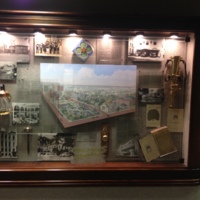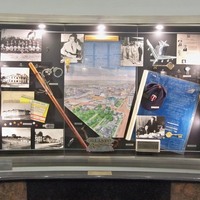How We Remember
Orlando Remembered's exhibits exist because a small group of concerned community members decided that the city was changing and that the past was in danger of being forgotten. Many of Orlando Remembered's earliest members recall Orlando as it was during the 1930s, 1940s, and 1950s. This bygone era represented a simpler and in many ways more elegant time in Orlando's past, before the the onslaught of unrelenting, homogenized urban sprawl. In 1981, with the scheduled destruction of the San Juan Hotel, longtime residents of Orlando feared that the City Beautiful's past was slipping away and sought a preserve it for future generations. The question was how to accomplish this task and connect the present day citizens of Orlando to their past. The preservation of entire buildings or the construction of large exhibits required more funding than the group could afford. Instead, Orlando Remembered decided that placing small exhibits that would tell the stories of former buildings and streetscapes was an affordable way to preserve the past while embracing the city's growth.
Orlando Remembered's move to document their memories reflects the impulse of many who face dramatic changes in their physical surroundings. Downtown Orlando has undergone significant changes since the 1930s, but these changes have been enacted in dozens of southern cities during the post-industrial period. Why then should the present day residents of Orlando concern themselves with the work of groups like Orlando Remembered? Why does our history matter? In the words of Peter Stearns, we remember because history is beautiful, history contributes to our moral understanding, and history helps provide us with our identity. In short, history is essential for good citizenship.
According to historian Mark Howell, "Our understanding of the past is as much a reflection of the generation doing the research as it is the period being studied." For many years cultural representations of the past have been the authority of large institutions and museums. The founding members of Orlando Remembered embarked on a different form of historical interpretation that was gaining ground during the 1970s and 1980s. The traditional museum was no longer the unquestioned authority of the past and citizens began to seek a voice in telling their own stories. These smaller, often collaborative, exhibits represent a shared authority over the past between the citizens of Orlando and the spatial areas they sought to remember.
Orlando Remembered's exhibits focus on bringing the past to the people and provide several key benefits over traditional museums.
-
The mobile nature of online and smaller, on-site exhibits are much more cost efficient to build and maintain.
-
The exhibits are more inclusive in their access, as anyone walking by or with an internet connection can view them.
-
Theexhibits transfer interpretive power from the institution to the individual through their collaborative nature.
References
Peter Stearns, "Why Study History," American Historical Association, 1998, https://www.historians.org/about-aha-and-membership/aha-history-and-archives/archives/why-study-history-(1998) (accessed January 5, 2016).
Mark Howell, "Interpreters and Museum Educators: Beyond the Blue Hairs," in Public History: Essays from the Field, ed. James Gardner and Peter LaPaglia (Malabar: Krieger Publishing Company, 2006),143.
Catherine Lewis, The Changing Face of Public History: The Chicago Historical Society and the Transformation of an American Museum, (DeKalb, Northern Illinois University Press: 2005) 5, 101.



